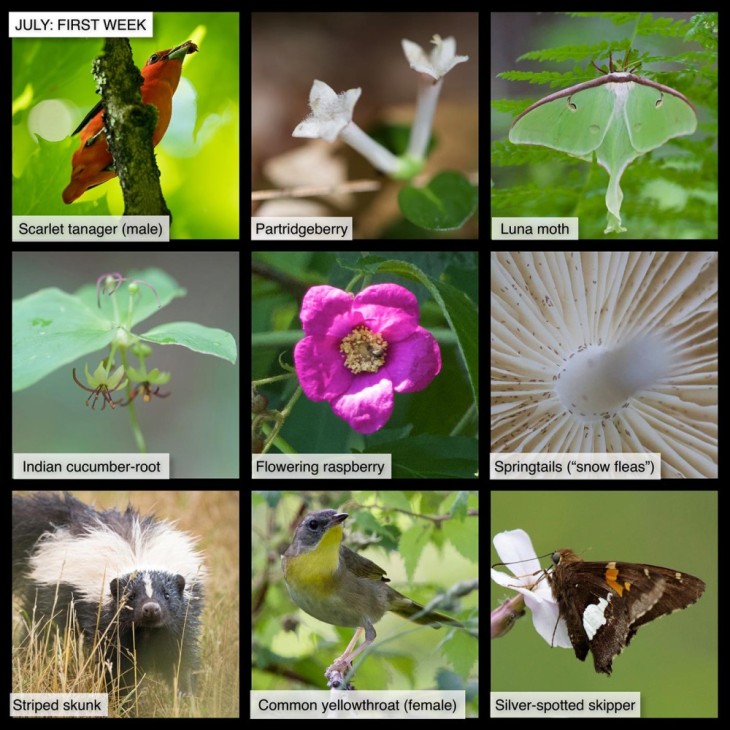This week in the woods, the spring chorus has simmered down, but there is still plenty of bird sound out there, including the “chick-brrr” of scarlet tanagers. The males appear as flashes of red in the trees; however, it’s rare to get a close look. This time of year, scarlet tanagers typically stay high up in oaks and other hardwoods, both to tend their nests and hunt insects. See this Outside Story article by Carolyn Lorié, and this Audubon Vermont link for further information, including sound files. The scarlet tanager is also Audubon Vermont’s “poster bird” for its Bird-Friendly Maple Project, focused on keeping “sugarbush habitat sweet for songbirds.” You can learn more about that project here.
Partridgeberry is blooming now, producing twin flowers. There’s a lot that’s surprising about this little plant’s approach to reproduction, including the requirement that both flowers must be pollinated in order to create one berry. Here’s an overview from the Brooklyn Botanic Garden.
We’re in the last days of enjoying this year’s luna moths. These exquisite insects, members of the giant silk moth (Saturniidae) family, don’t last very long as adults; they have no mouthparts and devote their energy reserves to breeding. Here’s an Outside Story essay about them from Susan Shea, including this note: the slightly twisted, trailing “tails” on their wings “interfere with echolocation by hunting bats.”
Indian cucumber-root supposedly started blooming in May, but this week was the first time we found flowers. The plant is part of the lily family, and although its flowers are much smaller than the ones you’ll find in the garden, they have the classic lily shape. The three long, curved purple-red prongs from the center of the bloom are the female stigmata. They thread in between the male stamens. A species profile and more images are available at the Lady Bird Johnson Wildflower Center website.
Flowering raspberry’s bright pink flowers with yellow centers are hard to miss. The plants grow abundantly on woods edges and clearings and can be a bit too assertive when they take a liking to the edge of your lawn. Although their berries aren’t especially sweet, they have one great advantage to most other raspberries (and blackberries): no thorns! Here’s a profile from The Native Plant Trust.
Have you ever wondered where snow fleas – more properly called springtails – go when there’s no snow? The short answer is they were already, and remain, pretty much everywhere, but they’re so tiny that they’re hard to see on the forest floor. Look for them on the undersides of mushrooms, a food source for some springtail species. Although to our eyes, springtails seem to hop like fleas, they actually have their own special self-catapult mechanism, and their own taxonomic class, Collembola, separate from insects. These “living fossils” have been around for at least 390 million years. Here’s a recent Outside Story article about aquatic springtails from Declan McCabe, and a blog post that includes some great close-up images by Jane Schlossberg.
It’s still a bit early for this year’s young striped skunks to come out of the den, but we encountered an adult happily hoovering up beetles. Given people’s dislike of skunks – they’re arguably even less popular than their weasel kin – it’s worth noting that most of the time, the animals live unnoticed lives. They’re mostly active between dusk and dawn, and often the only way you can tell that one has passed by is a nose probe in the field or forest floor. To see what a nose probe looks like, and to view a beautiful photo of a mother carrying a kit, see this article by Susan Morse.
Compared to scarlet tanagers, common yellowthroats are easy to find. They nest low to the ground, and they’re fairly bold – they may come close to get a better look at you. This female was perched in some brambles in an old field, but also look for the birds in wetlands, as well as other shrubby areas. The males, which have black masks and brighter yellow coloring than the females, are easy to identify at a glance. Here’s a U.S. Fish & Wildlife Service video on YouTube, which shows a male singing.
Silver-spotted skippers, so named for the distinctive patch on their chocolate wings, have recently appeared in fields and woods edges. Although their caterpillars feed on several native plants, including hopniss (American groundnut), they also have a taste for black locusts. This is a tree that originated in North America, but further south; it was imported to our region by early homesteaders. Here’s a profile of the species from “The Bug Guy,” entomologist Michael Raup, including videos of the butterfly and caterpillar, which also has a trick of webbing leaves together to hide from predators.
In this difficult period, many of us find joy in observing local nature, and many families are seeking outdoor enrichment opportunities for children. Here are nine photographs taken this past week, most within 15 miles of the Northern Woodlands office in Lyme, New Hampshire. We hope you enjoy using this grid as a prompt for your own explorations, or as the basis for a game of family forest tic-tac-toe.
What are you seeing in the woods this week? Share your images with us on Facebook, or submit a special photo for possible inclusion in our monthly online Reader Photo Gallery.



Discussion *